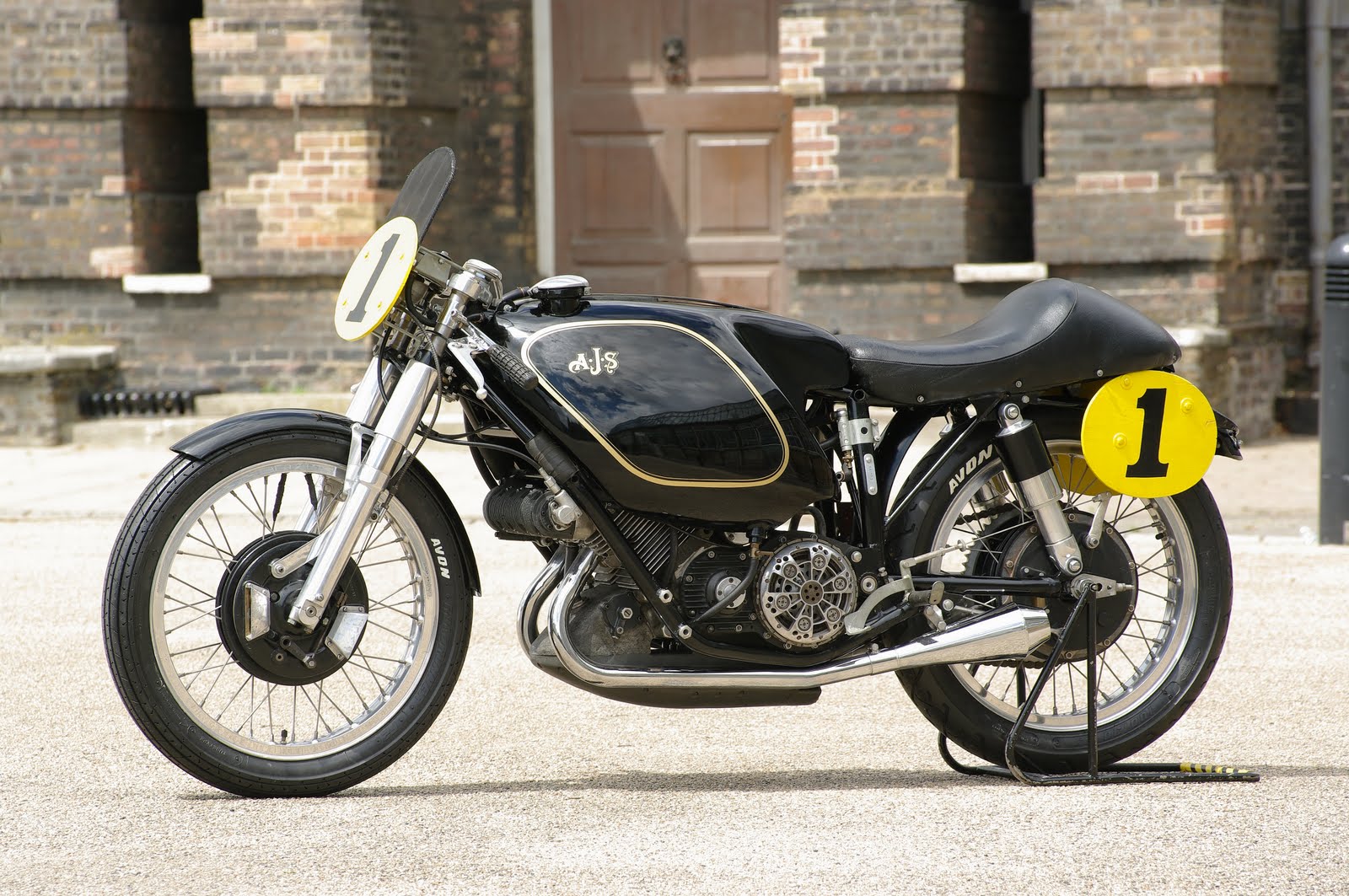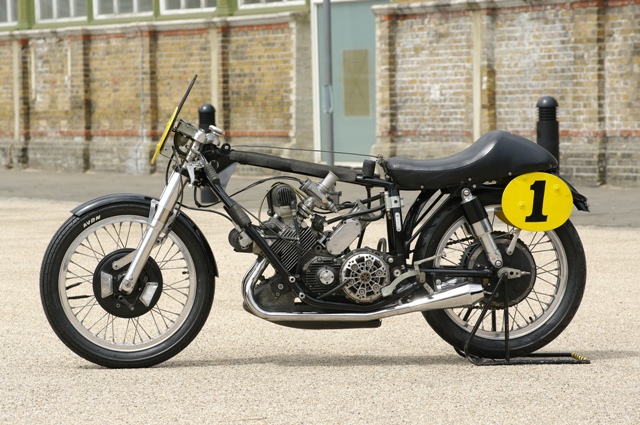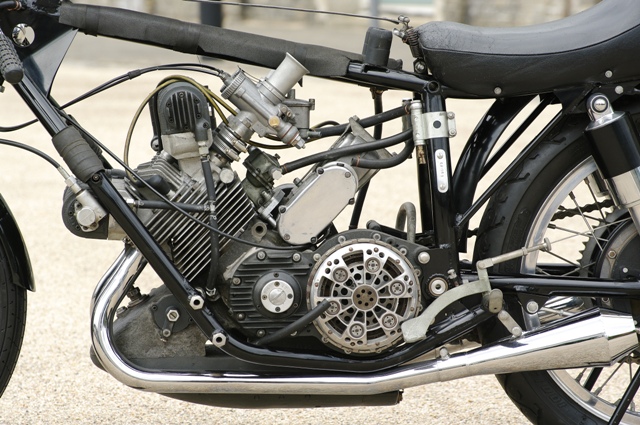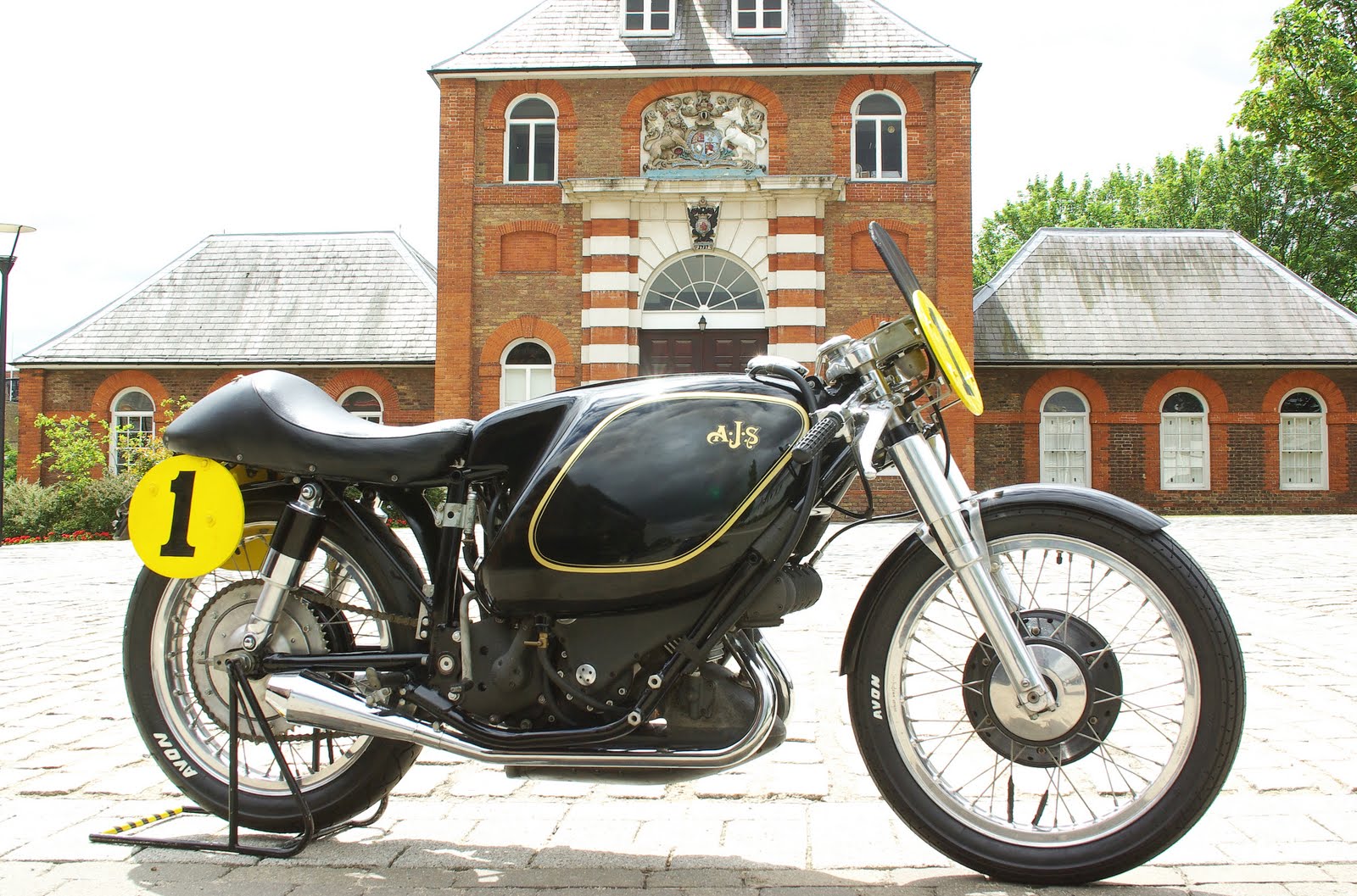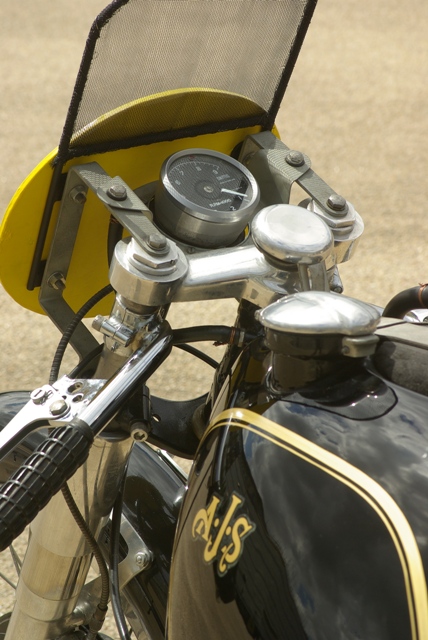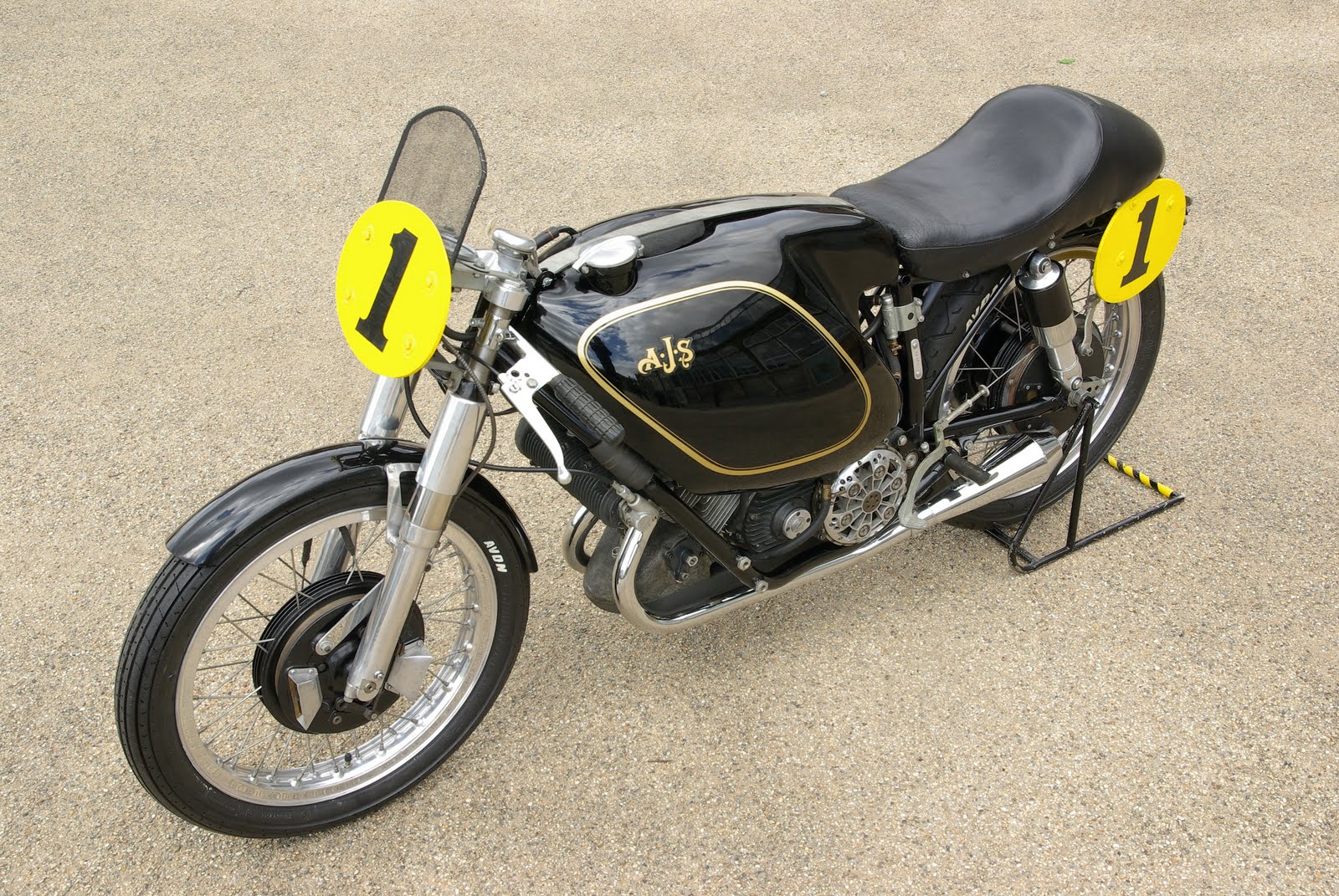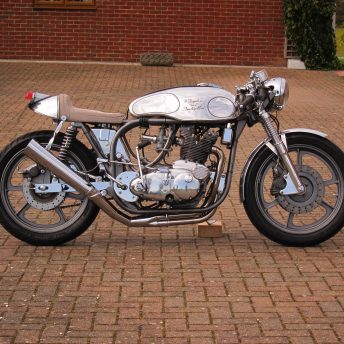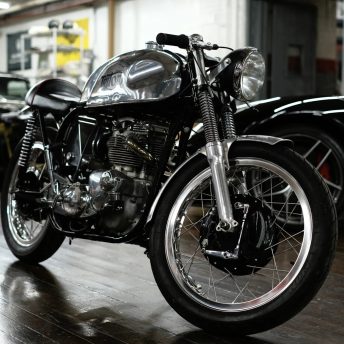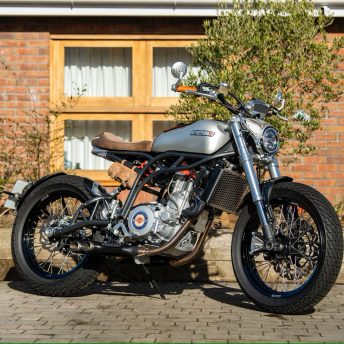1954 AJS 497cc E95 Porcupine ” Racing Motorcycle” Frame no. F3, Motor No E2 / 54
Britain’s first success in the modern era’s Grand Prix World Championships was achieved by a marque with an illustrious racing history – AJS. And the machine that carried Les Graham to his, and AJS’, first and only World Championship in 1949 was, of course, the legendary Porcupine. To this day the Porcupine remains the only twin-cylinder motorcycle to have won the 500cc World Championship. The 1954 AJS 500 c.c. E-95 Porcupine represents the final development of the most exotic, innovative, and graceful British Grand Prix racing motorcycle ever made. New for 1954, its final year of competition, the unique low handmade alloy “pannier” fuel tank wraps around the motor. The magnesium camboxes protrude out from under the front of the tank, capturing the cooling air.
Only four E-95‟s were built. They first appeared at the 1952 Isle of Man TT. Development continued, eventually under the genius of race shop head Jack Williams. For the 1954 Season he introduced the pannier fuel tank (which required a fuel pump) with the matching lowered chassis.
Unlike the rival works Nortons, the Porcupine shares little with the production machines sold to the public. The motor and gearbox are unit construction with gear primary drive. Power is transmitted through what may be the most beautiful exposed clutch ever seen. The long graceful cast alloy underslung oil tank is a full gallon in capacity. The twin overhead camshafts are driven by a train of gears that also drive the special aircraft magneto and the high capacity oil pump. Extensive use is made of lightweight ELECKTRON castings.
Conceived towards the end of WW2, the Porcupine was originally designed to be run either with or without forced induction. Supercharged multi-cylinder engines had begun to threaten the single’s supremacy towards the end of the 1930s and indeed, AJS themselves went down this road with their fearsome water-cooled V4. Fast yet difficult to handle, the latter had demonstrated that horsepower bought at the expense of excess bulk and weight was not the answer, so the thoughts of designer Vic Webb turned to a twin. Laying the cylinders almost horizontally with their heads facing forwards ensured adequate cooling and a low centre of gravity while at the same time providing room, if required, for a blower above the gearbox. When the FIM banned supercharging at the end of 1946, AJS was ready with new cylinder heads designed for normal aspiration!
Typed E90 but dubbed ‘Porcupine’ by the motorcycling press because of its distinctive spiked ‘head finning, AJS’ new challenger debuted at the 1947 Isle of Man TT in the hands of Les Graham and Jock West, the pair finishing 9 th and 14 th respectively after encountering a variety of minor problems. By way of consolation, West’s best lap was only three seconds down on the fastest and showed that the bike had promise. The Porcupine’s first race victory was achieved later that year by Ted Frend at the Hutchinson 100. Development continued throughout 1948, with a number of Grand Prix podium finishes and 18 world speed records among the season’s highlights.
The inaugural 500cc World Championship of 1949 consisted of six races, with victory going to Les Graham at the Swiss and Ulster Grands Prix. Bill Doran won the Belgian GP to assure AJS of the manufacturers’ title, while Graham’s two wins were enough to take the riders‟ championship from Gilera’s Nello Pagani.
Many years later, AJS works rider TedFrend – the first rider to win on the bike – recalled that carburetion had been the Porcupine’s biggest problem. Over the years several different induction arrangements were tried. Eventually, the 1954 pannier fuel tank and fuel pump solved this problem. The E90 was also bedevilled by failure of the gear driven magneto shafts – the cause of Graham’s retirement from the lead of the ’49 Senior TT just when two minutes from the finish. The problem was solved when chain drive for the magneto was adopted on the revised E95 engine. Introduced in 1952, the E95 engine had its cylinders tilted upwards at 45 degrees, an arrangement that permitted a shorter wheelbase. The new motor layout featured a more robust crankshaft, and improved cylinder head architecture. Its distinctive spike fins had gone, but the „Porcupine name stuck. The E95 enjoyed a dream debut, new recruit Jack Brett and Bill Doran finishing 1 st and 2 nd respectively at the season-opening Swiss Grand Prix, with New Zealand star Rod Coleman in 5 th place.
Another new addition to the AJS team for ’52, Coleman had first been given an E90 to try at the ’51 Ulster GP and followed that up with a strong showing at the Grand Prix Des Nations at Monza. “In the race it was quite definitely faster than the Nortons and I had little problem getting past Geoff (Duke) and Ken (Kavanagh) with just three Gileras only a short distance ahead,” Rod recalls in his book, The Colemans. I did get with them and found again that the Porcupine was just as fast as the Gileras but was down a little on acceleration from the slower corners, but not by much. I was just beginning to think I had every chance of second place behind Milani when the motor stopped.” The cause? Yet another magneto shaft failure.
For 1954, the final year of competition, the E95 Porcupine (and works ‘triple-knocker’ 7R3 350 single) gained the new pannier-style fuel tanks which extended down on either side of the engine, thus lowering the centre of gravity and affording a measure of streamlining at the same time. An AC fuel pump was used to raise fuel to the carburetors, a delivery system that involved mechanics standing the bike on its rear wheel to prime the internal header tank for starting! Jack Williams took over the race team that year and the result of his development was a much smoother engine, which now produced a maximum of 54bhp at 7,800rpm. Bob McIntyre, Derek Farrant and Rod Coleman were the riders, the latter providing the Porcupine with its best international results of the season, placing 2 nd in Ulster and winning the Swedish Grand Prix. Other riders to swing a leg over the Porcupine during its short career include Bill Lomas, Robin Sherry and Reg Armstrong.
Sadly, 1954 would prove to be the Porcupine’s swansong year. With the death of AMC founder Charlie Collier, AJS withdrew from direct involvement in Grand Prix racing at the season’s end, never to return. But the record books tell the story: between 1949 and 1954, Porcupines finished 24 races with five wins, seven 2 nd places and one World Championship. In total, only four complete E90 and four E95 machines were built. Only one E-90 survives.With the exception of the E95 acquired later by privateer Tom Arter, they were raced exclusively by the works team and never offered for public sale. Fortunately, all four E95s survive today. Two are in a Chartered Museum. One other is in private hands, owned by Team Obsolete. The E95 Porcupine offered here was acquired by the late Roy Richards, founder of the UK’s National Motorcycle Museum in the 1980s. On display at the Museum for decades, F3 was mechanically restored in the USA between 2000 and 2004 by New York-based Team Obsolete – luckily escaping the Museum‟s disastrous fire of 2003.
Quoted in Motorcycle Sport & Leisure magazine (August 2011 edition) Team Obsolete’s Rob Ianucci enthused about the Porcupine: It’s the Holy Grail of British motorcycles. It was conceived in the darkest days of the Second World War, and was created on limited budgets during the austerity of post-war Britain by dedicated men who were passionate about their craft. Yet they created a motorcycle which won the 500cc World Championship, and in my opinion was a truly beautiful mechanical object… It’s a two-wheeled work of art.
After the rebuild’s completion by Team Obsolete, the Porcupine went back to the NMM, arriving in time for its reopening in December 2004.
If you’re in the area I would strongly suggest dropping in and checking out the Team Obsolete motorcycle collection. Larry tells me they have quite an extensive collection of classic motorcycles including Cal Rayborn Harleys, Redman’s Honda 6, and the G-50 Matchless that Dave Roper won the Isle of Mann on, as well as many other Matchless G-50’s, Benelli 350/4’s, and MV Agusta prototypes from the 60’s.Thanks Larry.
This beautiful and very rare 1954 AJS Porcupine was sent in by Larry from Team Obsolete in Brooklyn, New York. This AJS was meticulously rebuilt by the Team Obsolete crew in 2004 and was due to go up for auction this month. Similar restored examples of these bikes have fetched over $200,000USD so if you happen to be a cashed up collector now’s the time to get in touch with them. Larry also provided a history of the AJS porcupine which is a great read for any motorcycle lover…
